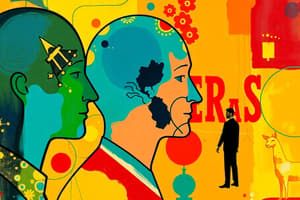Podcast
Questions and Answers
What is the first step in the decision-making process?
What is the first step in the decision-making process?
- Problem identifying (correct)
- Evaluating alternatives
- Choice of alternatives
- Identifying alternatives
Which of the following describes a characteristic of Feedforward controls?
Which of the following describes a characteristic of Feedforward controls?
- They monitor ongoing processes.
- They ensure compliance with existing regulations.
- They assess outcomes after a process has been completed.
- They provide corrective guidelines for future actions. (correct)
What distinguishes trait theories of leadership from other leadership theories?
What distinguishes trait theories of leadership from other leadership theories?
- Focus on specific situational contexts.
- Analysis of organizational structures.
- Consideration of followers' behaviors.
- Emphasis on the characteristics of an individual leader. (correct)
Which element is a key aspect of motivation theories?
Which element is a key aspect of motivation theories?
Which factor is not part of organizational structure evolution?
Which factor is not part of organizational structure evolution?
What is the primary goal of management?
What is the primary goal of management?
Which element is not part of the decision-making process?
Which element is not part of the decision-making process?
What does the term 'departmentalisation' refer to in organisation design?
What does the term 'departmentalisation' refer to in organisation design?
In what way is leadership crucial to an organization?
In what way is leadership crucial to an organization?
Which of the following is a characteristic of process theories of motivation?
Which of the following is a characteristic of process theories of motivation?
What type of control is primarily proactive in nature?
What type of control is primarily proactive in nature?
Which leadership theory emphasizes the importance of situational factors in leadership effectiveness?
Which leadership theory emphasizes the importance of situational factors in leadership effectiveness?
Which of the following statements is true regarding financial controls?
Which of the following statements is true regarding financial controls?
What is the primary focus of concurrent control within an organization?
What is the primary focus of concurrent control within an organization?
Which of the following is NOT considered a characteristic of effective control systems?
Which of the following is NOT considered a characteristic of effective control systems?
Which of the following financial controls is specifically used to compare an organization's performance against industry standards?
Which of the following financial controls is specifically used to compare an organization's performance against industry standards?
Which process falls under non-financial controls for monitoring project progress?
Which process falls under non-financial controls for monitoring project progress?
What is the main purpose of feedback control within an organization?
What is the main purpose of feedback control within an organization?
What is a potential disadvantage of geographical departmentalisation?
What is a potential disadvantage of geographical departmentalisation?
What does mixed departmentalisation primarily involve?
What does mixed departmentalisation primarily involve?
What have recent trends in organisational structure prioritized?
What have recent trends in organisational structure prioritized?
Which management theory emphasizes efficiency and control over employee autonomy?
Which management theory emphasizes efficiency and control over employee autonomy?
How does contingency theory contribute to organisational design?
How does contingency theory contribute to organisational design?
What role does Human Resource Management (HRM) play in organisations?
What role does Human Resource Management (HRM) play in organisations?
What challenge is associated with a company having a diverse product line?
What challenge is associated with a company having a diverse product line?
Which approach to organisational design focuses primarily on employee satisfaction?
Which approach to organisational design focuses primarily on employee satisfaction?
What is a consequence of adopting flatter hierarchies in organisations?
What is a consequence of adopting flatter hierarchies in organisations?
What has caused the shift towards more flexible job designs in modern organisations?
What has caused the shift towards more flexible job designs in modern organisations?
Which leadership style is focused on inspiring followers to achieve their full potential?
Which leadership style is focused on inspiring followers to achieve their full potential?
What is the main difference between transactional and transformational leadership?
What is the main difference between transactional and transformational leadership?
Which of the following needs is at the top of Maslow's hierarchy of needs?
Which of the following needs is at the top of Maslow's hierarchy of needs?
Which theory suggests that people can be motivated by multiple needs at the same time?
Which theory suggests that people can be motivated by multiple needs at the same time?
According to expectancy theory, which factor is essential for motivating individuals?
According to expectancy theory, which factor is essential for motivating individuals?
Herzberg's two-factor theory identifies which of the following as a hygiene factor?
Herzberg's two-factor theory identifies which of the following as a hygiene factor?
Equity theory focuses primarily on which of the following concepts?
Equity theory focuses primarily on which of the following concepts?
What aspect of motivation do process theories primarily examine?
What aspect of motivation do process theories primarily examine?
McClelland's achievement motivation theory emphasizes which needs?
McClelland's achievement motivation theory emphasizes which needs?
Motivation can best be described as which of the following?
Motivation can best be described as which of the following?
What is the main purpose of the evaluation step in the decision-making process?
What is the main purpose of the evaluation step in the decision-making process?
Which of the following best describes the component of 'spans of control' in organizational structure?
Which of the following best describes the component of 'spans of control' in organizational structure?
Which type of departmentalisation is most likely to lead to efficiency but may create silos?
Which type of departmentalisation is most likely to lead to efficiency but may create silos?
In the context of organisational design, what does formalisation refer to?
In the context of organisational design, what does formalisation refer to?
Which component of organizational structure addresses the obligation to fulfill tasks?
Which component of organizational structure addresses the obligation to fulfill tasks?
Which step directly follows the identification of alternatives in the decision-making process?
Which step directly follows the identification of alternatives in the decision-making process?
What is the central characteristic of structural operation in an organization?
What is the central characteristic of structural operation in an organization?
What is a potential drawback of product or service departmentalisation?
What is a potential drawback of product or service departmentalisation?
What is the primary purpose of HR planning?
What is the primary purpose of HR planning?
Which leadership theory emphasizes the personal qualities of a leader?
Which leadership theory emphasizes the personal qualities of a leader?
What is a key function of employee relations within HR?
What is a key function of employee relations within HR?
What aspect does contingency theory of leadership primarily consider?
What aspect does contingency theory of leadership primarily consider?
In performance appraisal, what is the main focus of the process?
In performance appraisal, what is the main focus of the process?
What is a characteristic of charismatic leadership theories?
What is a characteristic of charismatic leadership theories?
What is one of the criticisms of trait theories of leadership?
What is one of the criticisms of trait theories of leadership?
Which function of HR is primarily concerned with compensating employees?
Which function of HR is primarily concerned with compensating employees?
According to behavioral theories, which attributes are essential for effective leaders?
According to behavioral theories, which attributes are essential for effective leaders?
Which of the following best defines effective recruitment in HR?
Which of the following best defines effective recruitment in HR?
What is a major risk of geographical departmentalisation for multinational corporations?
What is a major risk of geographical departmentalisation for multinational corporations?
Which of the following is a characteristic of mixed departmentalisation?
Which of the following is a characteristic of mixed departmentalisation?
What is a key aspect of the evolution of organisational structures in recent years?
What is a key aspect of the evolution of organisational structures in recent years?
How does contingency theory inform organisational design?
How does contingency theory inform organisational design?
What has been a driving factor behind increased employee empowerment in organisations?
What has been a driving factor behind increased employee empowerment in organisations?
What is one potential disadvantage of adopting modern, flexible job designs?
What is one potential disadvantage of adopting modern, flexible job designs?
What was the primary focus of early approaches to organisational design?
What was the primary focus of early approaches to organisational design?
How did the human relations movement change perceptions of employee roles?
How did the human relations movement change perceptions of employee roles?
What is a potential consequence of having a diverse product line within a company?
What is a potential consequence of having a diverse product line within a company?
Which management function is primarily concerned with employee welfare?
Which management function is primarily concerned with employee welfare?
Which type of control is focused on preventing issues before they occur?
Which type of control is focused on preventing issues before they occur?
What characteristic is essential for a control system to be considered cost-effective?
What characteristic is essential for a control system to be considered cost-effective?
Which of the following is a key aspect of financial controls used for monitoring performance?
Which of the following is a key aspect of financial controls used for monitoring performance?
Which control type assesses outcomes and adjusts for future activities after they have been completed?
Which control type assesses outcomes and adjusts for future activities after they have been completed?
Among the following, which non-financial control specifically monitors the progress of ongoing projects?
Among the following, which non-financial control specifically monitors the progress of ongoing projects?
What is the primary distinction between transactional and transformational leadership?
What is the primary distinction between transactional and transformational leadership?
In Maslow's hierarchy of needs, which level must be satisfied before moving to higher levels?
In Maslow's hierarchy of needs, which level must be satisfied before moving to higher levels?
According to Alderfer's ERG theory, which of the following is NOT one of the need categories?
According to Alderfer's ERG theory, which of the following is NOT one of the need categories?
What key aspect does equity theory emphasize in motivation?
What key aspect does equity theory emphasize in motivation?
Herzberg's two-factor theory includes which of the following as a factor contributing to job satisfaction?
Herzberg's two-factor theory includes which of the following as a factor contributing to job satisfaction?
Which aspect does process theory of motivation primarily address?
Which aspect does process theory of motivation primarily address?
Which of the following best describes McClelland's achievement motivation theory?
Which of the following best describes McClelland's achievement motivation theory?
Which motivation theory suggests that belief in the value of rewards influences motivation?
Which motivation theory suggests that belief in the value of rewards influences motivation?
What type of factor in Herzberg's theory can lead to dissatisfaction if not met?
What type of factor in Herzberg's theory can lead to dissatisfaction if not met?
Which leadership style is primarily centered on inspiring followers rather than simply regulating performance?
Which leadership style is primarily centered on inspiring followers rather than simply regulating performance?
What is the main advantage of functional departmentalisation in an organization?
What is the main advantage of functional departmentalisation in an organization?
What characteristic distinguishes structural configuration from structural operation in an organizational context?
What characteristic distinguishes structural configuration from structural operation in an organizational context?
Which of the following best describes the role of evaluation in the decision-making process?
Which of the following best describes the role of evaluation in the decision-making process?
Which of the following factors can influence the degree of formalisation within an organizational structure?
Which of the following factors can influence the degree of formalisation within an organizational structure?
How does hierarchical structure primarily affect an organization?
How does hierarchical structure primarily affect an organization?
What is a potential disadvantage of decentralised decision-making?
What is a potential disadvantage of decentralised decision-making?
Which aspect is NOT a characteristic of responsibility in organizational structure?
Which aspect is NOT a characteristic of responsibility in organizational structure?
Which strategy might a company use to mitigate the drawbacks of product or service departmentalisation?
Which strategy might a company use to mitigate the drawbacks of product or service departmentalisation?
What is the primary focus of HR planning?
What is the primary focus of HR planning?
Which of the following best describes behavioral theories of leadership?
Which of the following best describes behavioral theories of leadership?
Charismatic theories of leadership primarily focus on which aspect?
Charismatic theories of leadership primarily focus on which aspect?
Contingency theories of leadership suggest that effective leadership depends on what?
Contingency theories of leadership suggest that effective leadership depends on what?
Which of the following is NOT typically a focus of employee relations within HR?
Which of the following is NOT typically a focus of employee relations within HR?
What element is central to leadership distinct from management?
What element is central to leadership distinct from management?
Which of the following is a common criticism of trait theories of leadership?
Which of the following is a common criticism of trait theories of leadership?
What is a key outcome of effective performance appraisal?
What is a key outcome of effective performance appraisal?
What key aspect distinguishes selection from recruitment in the HR function?
What key aspect distinguishes selection from recruitment in the HR function?
What is the role of training and development within the HR function?
What is the role of training and development within the HR function?
Flashcards
Management Definition
Management Definition
Management is a process where managers use resources (people, money, knowledge, things) to reach company goals.
Decision-Making Steps
Decision-Making Steps
Problem identification, alternative generation, alternative evaluation, choice, implementation, and evaluation comprise the decision-making process.
Organizational Structure
Organizational Structure
Organizational structure involves how departments are set up and how the company is organized.
Leadership Importance
Leadership Importance
Signup and view all the flashcards
Organizational Control Types
Organizational Control Types
Signup and view all the flashcards
What is management?
What is management?
Signup and view all the flashcards
Departmentalization
Departmentalization
Signup and view all the flashcards
HR Functions
HR Functions
Signup and view all the flashcards
Leadership's Impact
Leadership's Impact
Signup and view all the flashcards
Leadership Theories
Leadership Theories
Signup and view all the flashcards
Motivation: Why people act
Motivation: Why people act
Signup and view all the flashcards
Control: Ensuring success
Control: Ensuring success
Signup and view all the flashcards
Decision-Making Process
Decision-Making Process
Signup and view all the flashcards
Problem Identification
Problem Identification
Signup and view all the flashcards
Generating Alternatives
Generating Alternatives
Signup and view all the flashcards
Evaluating Alternatives
Evaluating Alternatives
Signup and view all the flashcards
Division of Labor
Division of Labor
Signup and view all the flashcards
Span of Control
Span of Control
Signup and view all the flashcards
Product Departmentalisation
Product Departmentalisation
Signup and view all the flashcards
Geographical Departmentalisation
Geographical Departmentalisation
Signup and view all the flashcards
Mixed Departmentalisation
Mixed Departmentalisation
Signup and view all the flashcards
Scientific Management
Scientific Management
Signup and view all the flashcards
Human Relations Movement
Human Relations Movement
Signup and view all the flashcards
Contingency Theory
Contingency Theory
Signup and view all the flashcards
Flat Hierarchies
Flat Hierarchies
Signup and view all the flashcards
Flexible Job Designs
Flexible Job Designs
Signup and view all the flashcards
Employee Empowerment
Employee Empowerment
Signup and view all the flashcards
Human Resource Management (HRM)
Human Resource Management (HRM)
Signup and view all the flashcards
Feedforward Control
Feedforward Control
Signup and view all the flashcards
Concurrent Control
Concurrent Control
Signup and view all the flashcards
Feedback Control
Feedback Control
Signup and view all the flashcards
Financial Controls
Financial Controls
Signup and view all the flashcards
Non-Financial Controls
Non-Financial Controls
Signup and view all the flashcards
HR Planning
HR Planning
Signup and view all the flashcards
Recruitment
Recruitment
Signup and view all the flashcards
Selection
Selection
Signup and view all the flashcards
Pay and Benefits
Pay and Benefits
Signup and view all the flashcards
Performance Appraisal
Performance Appraisal
Signup and view all the flashcards
Training and Development
Training and Development
Signup and view all the flashcards
Employee Relations
Employee Relations
Signup and view all the flashcards
Leadership vs. Management
Leadership vs. Management
Signup and view all the flashcards
Trait Theories
Trait Theories
Signup and view all the flashcards
Behavioral Theories
Behavioral Theories
Signup and view all the flashcards
Transactional Leadership
Transactional Leadership
Signup and view all the flashcards
Transformational Leadership
Transformational Leadership
Signup and view all the flashcards
What motivates people?
What motivates people?
Signup and view all the flashcards
Maslow's Hierarchy
Maslow's Hierarchy
Signup and view all the flashcards
Alderfer's ERG Theory
Alderfer's ERG Theory
Signup and view all the flashcards
McClelland's Achievement Motivation
McClelland's Achievement Motivation
Signup and view all the flashcards
Herzberg's Two-Factor Theory
Herzberg's Two-Factor Theory
Signup and view all the flashcards
Expectancy Theory
Expectancy Theory
Signup and view all the flashcards
Equity Theory
Equity Theory
Signup and view all the flashcards
Control in Organizations
Control in Organizations
Signup and view all the flashcards
Functional Structure
Functional Structure
Signup and view all the flashcards
Hierarchy
Hierarchy
Signup and view all the flashcards
Formalisation
Formalisation
Signup and view all the flashcards
Centralized Decision-Making
Centralized Decision-Making
Signup and view all the flashcards
Trait Theories of Leadership
Trait Theories of Leadership
Signup and view all the flashcards
Behavioral Theories of Leadership
Behavioral Theories of Leadership
Signup and view all the flashcards
HRM (Human Resource Management)
HRM (Human Resource Management)
Signup and view all the flashcards
Budgetary Control
Budgetary Control
Signup and view all the flashcards
Break-Even Analysis
Break-Even Analysis
Signup and view all the flashcards
Motivation
Motivation
Signup and view all the flashcards
Content Theories of Motivation
Content Theories of Motivation
Signup and view all the flashcards
Process Theories of Motivation
Process Theories of Motivation
Signup and view all the flashcards
Maslow's Hierarchy of Needs
Maslow's Hierarchy of Needs
Signup and view all the flashcards
Hygiene Factors (Herzberg's Two-Factor Theory)
Hygiene Factors (Herzberg's Two-Factor Theory)
Signup and view all the flashcards
Study Notes
Management Principles Exam
- Management is a process where managers achieve organizational goals using human, financial, knowledge, and physical resources.
Planning
- Decision Making Process:
- Identifying problems
- Identifying alternatives
- Evaluating alternatives
- Choosing the best alternative
- Implementing the decision
- Evaluating the result
Organisation Design
- Distinction between structural configuration and operational aspects.
- Types of departmentalization
- How organizational structure evolves.
Managing Human Resources
- Understanding key areas of the HR function.
Leadership
- Importance of leadership in organizational functioning.
- Understanding different leadership theories (trait, behavioural, contingency, charismatic).
Motivation
- Understanding why people behave in specific ways.
- Comparing content and process theories of motivation.
Control
- Control's importance for organizational survival.
- Difference between feedforward, concurrent, and feedback control.
- Common financial and non-financial controls.
Exam Format
- 1 hour and 30 minutes
- 40 multiple-choice questions (MCQs) with five possible answers (a, b, c, d, e).
Studying That Suits You
Use AI to generate personalized quizzes and flashcards to suit your learning preferences.




